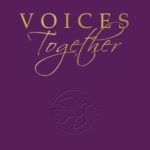This blog is reprinted with permission from Anabaptist Worship Network and is part of our series on Voices Together, the new worship and song collection from MennoMedia, in partnership with Mennonite Church USA and Mennonite Church Canada.
 Anneli Loepp Thiessen is a Ph.D. student in Interdisciplinary Music Research at the University of Ottawa, where she studies diversity and equity in the contemporary worship music industry. She is a co-director of Anabaptist Worship Network and director of Ontario Mennonite Music Camp. Anneli was honored to serve as a committee member for the Voices Together hymnal.
Anneli Loepp Thiessen is a Ph.D. student in Interdisciplinary Music Research at the University of Ottawa, where she studies diversity and equity in the contemporary worship music industry. She is a co-director of Anabaptist Worship Network and director of Ontario Mennonite Music Camp. Anneli was honored to serve as a committee member for the Voices Together hymnal.
_____________________
As churches across Canada and the United States gradually reopen their sanctuaries for corporate worship, questions emerge about the safety of congregational singing. For some communities, it has been decided that congregational singing is not a safe act of worship for the next few months, with the ongoing development and aftermath of COVID-19. The task of planning corporate, in person worship without singing can feel daunting, particularly for communities that experience congregational singing as the centre of worship. For many congregations, our singing has done the heavy lifting of praise, prayer, and connection. Perhaps this push not to sing can be viewed as a welcome nudge to broaden our practice of worship, to step away from busyness and enter into expansive space. Perhaps worshipping without singing is not a burden, but an opportunity to explore new ways of connecting with God and each other. Here are some ideas to get started:
- Add actions to songs. One of the gifts of singing is the ability to participate in a corporate expression. We can replicate this experience by physically moving together. Teaching a congregation actions for a song is a way to embody the lyrics and to participate in a collective movement. Ontario Mennonite Music Camp has put together videos with actions for three songs in Voices Together: Holy Lord, Christ Be All Around Me, and Like a Rock.
- Use dance. Another way to express shared movement is through dancing together, or using basic gestures. A small ensemble of dancers may be a suitable option, or it may be possible to teach the congregation very basic dance steps. For more on this see #95 “Dance” in the Worship Leader Edition.
- Invite the community to assume gestures or postures. You may invite people to outstretch their arms during a congregational prayer, or to raise hands during a song of praise. For more on this see #92 “Postures and Gestures in Worship” in the Worship Leader Edition.
- Offer percussion Instruments. Have people bring their own percussion or other instruments, or offer some at the church. Congregants could be invited to shake their keys, use body percussion, or use homemade percussion instruments like shakers. Consider whether a song would sound joyful with a cacophony, or if it would benefit from teaching one (or several) rhythmic lines. An additional resource for this is All Hands In: Drumming the Biblical Narrative by Brian Hehn and Mark Burrows.
- Invite silence. Silence may be one of the most overlooked components of worship, but is certainly a source of revitalization and connection. Silence can be offered as a time for reflection, prayer, and meditation. For more on this, see #338 “Silence” in the Worship Leader Edition.
- Offer instrumental music. “Special music” is a staple of some community services, and is an opportunity to worship and reflect through the musical offering of another. Likely any children or youth in your community who take music lessons haven’t been able to perform in over a year, so they may be grateful for the opportunity to offer their gifts. For more on this, see #76 “Musical Offerings” in the Worship Leader Edition.
- Share videos in worship. Many communities learned to rely on videos in worship during virtual worship, but they are great resources for in-person worship as well. In the absence of singing, you may want to continue putting together virtual choirs or sharing videos of members of your community singing. For more on this, see #49 “Video Technology in Worship” in the Worship Leader Edition.
- Lead visio or lectio divina. These ancient practices invite focused reflection on either visual art or scripture. These practices can be offered in lieu of a sermon or prayer, or as a supplement to a regular service. For more on these, see #45 “Visio divina” and #198 “Lectio divina” in the Worship Leader Edition.
- Offer a short drama. Drama is an alternative way to tell scripture or other stories, and engages artistic expression beyond music. Ted & Co. is a Mennonite drama company that has made some of their scripts available online. For more on drama in worship, see #176 “Drama in Worship” in the Worship Leader Edition.
If your community is worshipping primarily via Zoom or another online platform, you may find these suggestions for virtual singing helpful.
This season offers an opportunity to revitalize our worship, and to experiment with practices we usually might not have space for. Be blessed as you engage your creativity and imagination in worship planning.
For more information on Voices Together, visit voicestogetherhymnal.org.
The views and opinions expressed in this blog belong to the author and are not intended to represent the views of the MC USA Executive Board or staff.


